Feature Interview with Connor T. Lewis
May, 2021
Connor T. Lewis founded The Society of Golf Historians in 2018 and is the host of the popular TalkinGolf History podcast. Both are non-commercial ventures.
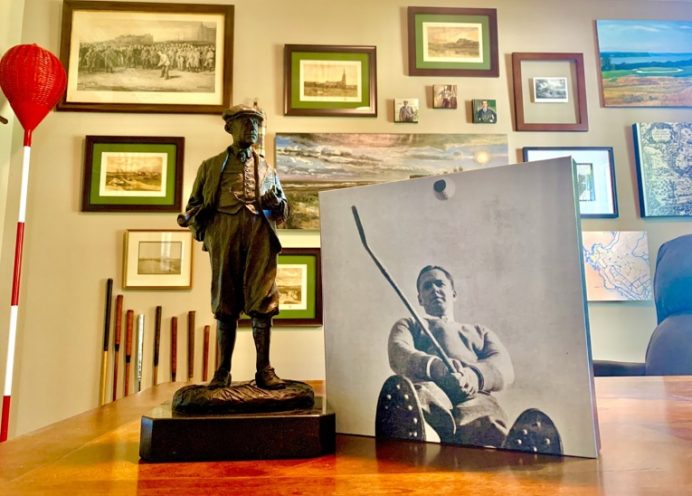
The home office is pretty much what you would expect for a historian!
1. How did you veer into the study of golf history? Were there a few key events that helped propel you along the way?
History has always appealed to me going back to grade school. I picked up golf later in my life (age of 28) and it wasn’t long after that I connected the two.
My addiction to golf history was really jump started in 2007. I was living in Iowa at the time, and we were in the middle of a horrible winter and on somewhat of a whim, I decided to drive to the Des Moines golf dome to hit golf balls. Unfortunately, when I arrived, I realized that they were having an end of the year clearance sale for every golf shop in Des Moines. I wandered through the racks of flamingo polo shirts until I ran into two guys wearing knickers and newsboy caps – William Reed and Russ Fisher. They had a booth of hickory shafted clubs and the history buff in me was instantly attracted to those old sticks and within 30 minutes, I found myself hitting a hickory shafted Walter Hagen driver. Something in me snapped- I realized that I couldn’t really know anything about golf history if I didn’t understand the equipment of the past.
Within 3 months I had acquired a set of Tom Stewart RTJ’s (a copy of a set Tom Stewart made for Bobby Jones in his prime) and 4 months after that I traveled to Scotland to play many of the great Open Championship courses with hickories. When I came back to the USA, I threw away my modern clubs and played only hickories for 5 years. If that isn’t entirely off the deep end, after 5 years of playing only hickory golf, I decided I didn’t know enough about the pre-1900 era of golf, so I gave up hickories for pre-1900 gutty era clubs. For two straight years I only played gutty golf.
So yah I am a little crazy about golf history.
2. Frame for us the difference in how the game was played pre and post Haskell. For instance, how far could you hit a driver and mashie with pre-1900 equipment and post-1900 equipment.
It’s difficult to describe the difference between gutty golf and Haskell golf, because they really feel like different sports. A friend of mine, the 8-time National Hickory Champion (Gutty Golf Tournament), Randy Jensen once said, “The difference between golf from 1895 to 1905 is far greater than from 1905 to today.” After playing hickory golf for 5 years straight and then only gutty golf for 2 years straight, I can tell you that statement is a fact. People who have never played hickory golf are often blown away at how similar it is to the modern game – yes the ball flies shorter and doesn’t spin as much, but it’s golf.
Gutty Golf is not like modern golf, heck it’s not like hickory golf– as a matter-of-fact part of the reason I only played gutty golf for 2 years because the game is so different. To play both was a recipe for playing both poorly – fewer clubs, less distance, less spin, the clubs weighed 10 swing-weights or more than hickory clubs – it was like playing golf with a club the weight of an axe…AND IT WAS AMAZING!
As for your question on distance, for me, I could poke a hickory driver out there 250+ yards, but with a long nose play club and a gutta percha ball a long drive and I mean LONG DRIVE for me was maybe 200 yards and more likely 185-190 yards.
I like the second part of your question about the mashie distance – because the mashie was an invention of the longer flying Haskell Ball. There wasn’t a mashie in gutty golf. For the most part you had a club for every 10 degrees of loft.
3. Please describe in detail your pre-Haskell play set.
My play set consisted of:
Long Nose Playclub (driver): 10* Wm Park & Sons (Musselburgh) = 180ish yards
Long Nose Brassie (think 2 wood): 16* McEwan (Musselburgh) = 165ish yards
Cleek: 20* Carrick (Musselburgh) = 150ish yards
General Iron: 30*Carrick (Musselburgh) = 140ish yards
Lofter: 40* Carrick (Musselburgh) = 130ish yards
Rut Iron: 48* Carrick (Musselburgh) also too heavy to be on the swing weight scale and a shaft nearly as wide as a broomstick = if you take a full swing you are an idiot! The damn face is the size of a golf ball and the hosel is half the size of a golf ball! A full swing is a recipe for a shank.
Long Nose Putter: McEwan (Musselburgh)
You only needed 7 clubs and if you will oblige me a bit, there is a little history behind why we play 14 clubs and not 7. With the gutta percha ball, most players carried somewhere between 6-8 clubs. Why? It really was a matter of mathematics. With these 7 clubs (well 6 clubs and a putter), there was a perfect disbursement of 10 yard gaps between clubs. When the Haskell was introduced and then popularized, nearly every golfer picked up 30-50 yards off the tee. All of a sudden we needed to fill those 10 yard gaps and soon after the Haskell we had new clubs like the mashie, the mashie iron, spade mashie, mashie niblick, and the niblick. Players needed more clubs to fill those distance gaps and form essentially followed function. Now in the 1920s and 1930s it got out of control with players like Lawson Little, Walter Hagen and Harry “Lighthorse” Cooper carrying as many as 27-30 clubs in their golf bags, but our current 14 club standard is based on distance gaps.
4. What is the purpose of The Society of Golf Historians, now in its third year?
I imagine its purpose echoes the purpose of Golf Club Atlas. I wanted to create a place where people could teach, people could learn, share their findings and ask questions. I love golf historians, but I wanted a society that didn’t just cater to historians. I wanted to create a society that at its core was inviting to all. Now pushing 30,000 members I am at a complete loss as to how this happened. I will say that the Society, as well as the podcast TalkinGolf History, are not stuffy. Our aim is to be engaging and entertaining while hopefully educating. There is no professor with a pipe and a monocle on the other end of the podcast.
5. When did you start your podcast TalkinGolf History?
The podcast and the Society are nearly the same age. Rod Morri and Adrian Logue, both out of Australia, interviewed me for a podcast 3 years ago and when we concluded Rod told me that I needed to start a podcast. My immediate response was, “Who the hell would listen to it?” 3 years in and I am still amazed how large our audience is – especially because I generally refuse to chase topics that guarantee high ratings. I am not saying I won’t do a podcast on Jack Nicklaus or Tiger Woods, but I would argue we know so much about them already. For a topic to make the podcast I have to be all in!
6. Tell us some of your favorite editions relative to golf course architecture and what special bit of information you gleaned in each?
What an incredibly hard question!!!!
We have done a series on our greatest architects with completed shows on Dr. Alister Mackenzie, Donald Ross, Harry Colt, Seth Raynor, Walter Travis and Perry Maxwell. Golf course architecture holds a special place in my heart because it is the one thing that is seemingly infinite – major champions and golf course architects pass away, but the field of play is eternal. Golf courses, in my mind, are also living breathing works of art & we are lucky enough to play games on these Picassos.
To me, history is what ties all of golf history to the modern age. Therefore, the episode “Restoration with Ron Forse” would be up there. It was my first sit-down interview with a golf course architect and one who specializes in restoration. We spoke about his work at Newport CC, Davenport CC, Indian Creek and others. I am a big golf nerd when it comes to golf course architecture and specifically architects, so to dive into what is “restoration” was a fun interview, found here (https://talkingolf.fireside.fm/40).
Another is a show that likely had its origin on this very site, “The Lost Routings of Cypress Point” with special guests Sven Nilsen and Bret Lawrence. If examining the history and design of Cypress Point isn’t amazing, just walk away because we are going to get into a fight! It’s a mystery wrapped up in one of the world’s best courses. Is the routing that of Seth Raynor, Marion Hollins, Dr. MacKenzie??? Fascinating stuff, (https://talkingolf.fireside.fm/37).
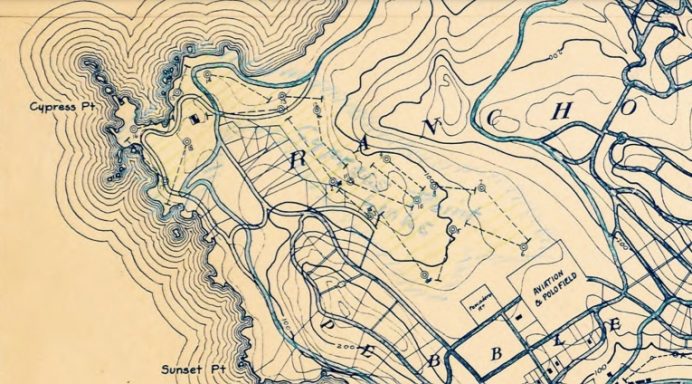
This map pre-dates Alister MacKenzie’s involvement in Cypress Point.
Speaking of Alister Mackenzie, “The Evolution of Augusta National” (two-part series) is another genuine favorite. On this show we walked through every hole at Augusta National and how it changed from Mackenzie’s original drawings to the course that was built in the early 30s and then from the original course to what we have today. Since that podcast aired, I have had the chance to play Augusta National which was a real treat – it’s one thing talking about how it evolved over time and something completely different playing ANGC and thinking about how it evolved while your feet are walking upon that sacred ground. It was borderline religious. Part one is here (https://talkingolf.fireside.fm/52) and part two (https://talkingolf.fireside.fm/53).
Finally, I really enjoyed our recent episode “The Gathering.” It was a great panel of experts all looking at Donald Ross and golf course architecture from their own viewing glass of experience. I walked away from that show with hope for the game’s future. Any episode I get to partner up with Vaughn Halyard and Story Lounge Film Company is a special one. Vaughn and I make a good team and have a great time together. Listen to it here (https://talkingolf.fireside.fm/63).
7. Please share a favorite golf story or two from your travels.
My favorite stories are usually tangent to the golf course. For instance, quite a few people have played the National Golf Links of America, but how many people have studied its routing? The 10th at NGLA used to be the first hole, because its original clubhouse was the Shinnecock Inn, a hotel that burnt to the ground one year after the club opened. On my last trip to NGLA I spent a couple of hours after my round inspecting the ruins of the Shinnecock Inn, which sits back in the woods behind the 10th tee. The oldest building on the property is the snack shack on the 10th, but its original purpose was the starters shed-where the player would pick up their caddy and head out to play. Then there is the much smaller but intricate and ornate original gate to the club. The story of the ruins of the Shinnecock Inn is fascinating to me.
But one of my all-time favorite stories, which was also a topic from my podcast is “The Golf Club That Time Forgot.” It’s the story of Lake Zurich Golf Club in the suburbs of Chicago. Lake Zurich is a magical place and is one of those clubs that, if invited to join, I could never say no. It may also be the most exclusive club in the USA with no pomp and circumstance, and only 27 members with a charter that won’t allow for more than 35 members. The club was nearly designed by CB Macdonald in the mid-1890s, but instead Macdonald recommended the head pro of Chicago Golf Club for the job -James Foulis. I don’t know this for a fact, but I believe this was Foulis’ first design in America. There are really too many stories to tell, so let me give you the hook that will make you want to find this podcast episode… In 1910 the railroad was planning on condemning the golf course using its power of eminent domain.
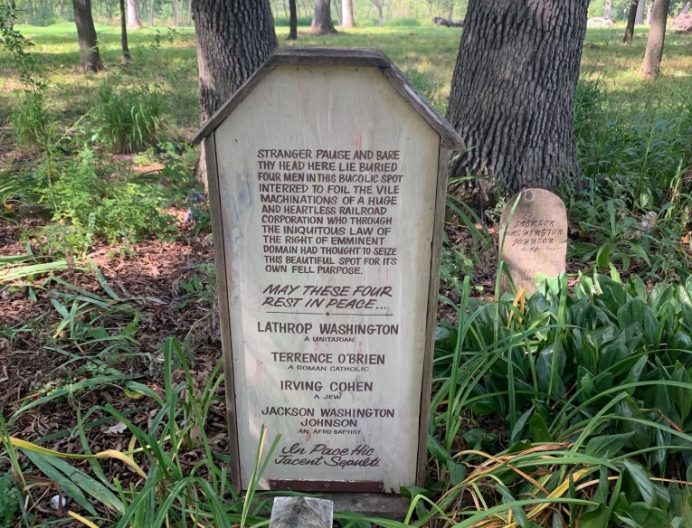
The quick-thinking president of the club also happened to be a professor of law at the University of Chicago. He realized that the golf club couldn’t keep the railroad from taking their land “as a golf course”, but you can’t condemn a cemetery, so under the cover of darkness members of the Lake Zurich Golf Club took unclaimed bodies from the morgue and buried them on the golf course, tombstones and all! Then the club president re-zoned the property as a cemetery, thus saving the club.
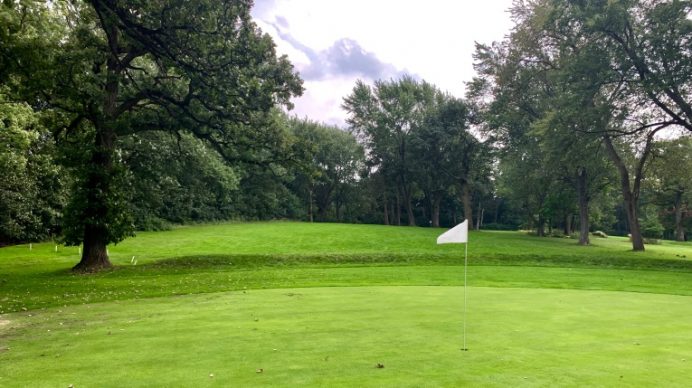
Looking back up the 3rd hole.
Those men who were buried on the course still hold a special place of honor and when you play there you tip your cap to them as you play down the first hole. Lake Zurich is a special place, it has been untouched by man since the late 1890s. The greens might roll to a 5, there are still a couple of steeple chase hazards on its grounds and the Jarvis Hunt clubhouse is a marvel that must be seen. It is living history.
I also have a new series coming out as part of TalkinGolf History called “A Golf Historian’s Guide to…” Our first episode will be “A Golf Historian’s Guide to Pinehurst” with Chris Buie. The show will travel all over the world interviewing and filming historians and golf historians about the history of our golf epicenters.
8. Excellent to hear – no one knows the evolution of the game in Pinehurst better than Chris. Are there other examples of where you love of history has taken you to cool, off-the-radar places in North America akin to Lake Zurich?
I will give you two, and one of them is a course that has been lost forever. Ok so before I start, I am a bit addicted to golf courses that no longer exist. One could argue that I cut my teeth on the Twitter Thread and the Golf Channel piece that followed with Jim Urbina on the Lost Legend of the Lido Club. There is something magical about those things that are seemingly lost forever. They represent a history that can’t quite be relived. Whether that’s an artistic loss or nostalgia, I just find it fascinating.
On that theme, the first one is Harleston Green which resulted in the podcast, “The Birth and Death of Golf in America.” Harleston Green is America’s first known golf course dating back to 1786. It was home to America’s first known golf course and first known golf club, which technically made it the oldest golf club outside of the UK. That experience of walking around Harleston Green and the parallel story that I shared on the podcast with slavery makes it a favorite.
The second course was nothing you would write home about and it comes to mind because it depressed me. I did a show called, “The Golf Club Without a Course” about the Pittsburgh Golf Club and while it doesn’t have a course (the city made it public), their original course sits out in front of their clubhouse 124 years later. So in researching the story I walked a bit of the golf course and quickly realized that they still had their original Victorian Steeplechase hazards. To my horror, the course was building a new clubhouse and the bulldozers were driving over what was left of those steeplechase hazards. Like a complete psycho I ran over and tried to redirect the bulldozer. The course, now called “The Bob” is due for a renovation and I fear that the Victorian nature of the course will be lost to modernization.
9. Not good! There are aspects to Victorian architecture that are vastly underestimated. Let’s move now to literature and art. What captivates you about John Smarts’ work?
Another loaded question! My answer may have to be a book someday (maybe you can write it Ran). I am considering writing an article on Smart, as he may just be the first man/woman to truly capture golf course architecture in the visual form. Previous artists might have painted a landscape of St Andrews or Musselburgh, but none that I am aware of, painted a series of golf courses (1880s) where the golf courses were the subject and not the golfers. The only identifiable golfer in any of his paintings is Old Tom Morris (in Smart’s remarkable painting of Hell Bunker). In John Smart’s defense, I think it might have been against the law in the 1880’s to not include Tom Morris in any image of St Andrews.
10. Please share with us his version of the Hell Bunker and your thoughts on it.
Ohhhh can a painting be sexy? Nobody in the history of time has ever painted a better version of Hell Bunker. John Smart painted Hell Bunker in the 1880s and in it I literally see Dante’s Inferno- a swirling sandscape of peril, eerily similar to Dante’s lost souls in hell. I am a lover of golf art and this painting just speaks to me- never has there been a finer visual representation of Hell and I mean Hell, not just the hazard.
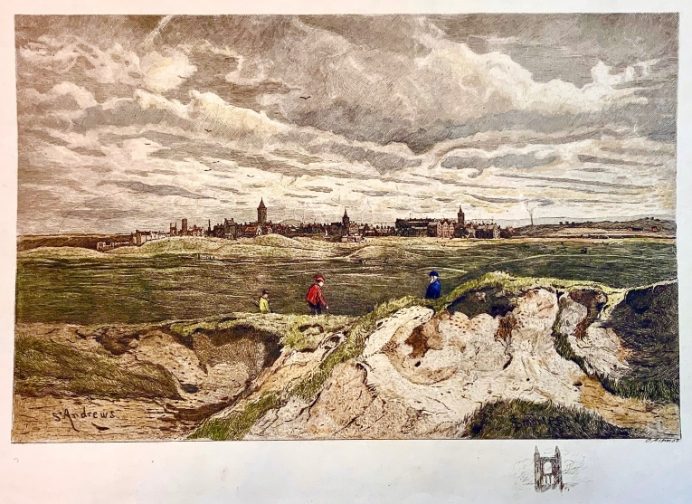
11. You and I are both enormous fans of Sir Peter Allen. What do you find compelling about his writing? How did you – temporarily – come to have his personal journals in your possession?
I can sum it up in one word, “passion.” Sir Peter Allen loved the game to his very core. Here is a man who could have seen the world as his oyster, but his writings and his journal are so refreshing- his passion to me is infectious. His love for golf and golf architecture is pure. Interestingly enough, a friend was given some of Sir Peter Allen’s personal journals which catalogue his golf experiences throughout his lifetime. I got to peruse them and they are beyond words – from his original photos of Pine Valley to his scorecards; it’s just a remarkable collection of memories from one of golf’s great international ambassadors.
12. How does an appreciation of history shape your approach to golf?
Tough question because I don’t know how to separate the two of them. I never think about one without the other. I would like to think in some ways it keeps me grounded because history does in fact repeat itself all the time.
13. Please share with us an interesting factoid deep in the bowels of golf history.
Well, there is the time that King James II banned golf back in 1600’s.
King James II and his son King James III teach us one thing … don’t bet against golf because karma will get you!
Both King James II and his son banned our beloved sport in an effort to keep their armies engaged. I personally think their armies needed a little R&R and as a result both of their armies lost and both kings lost their lives in the process. King James IV fortunately reversed ban and in fact joined the league of golfers, becoming the first “known” golfer to purchase a set of clubs.
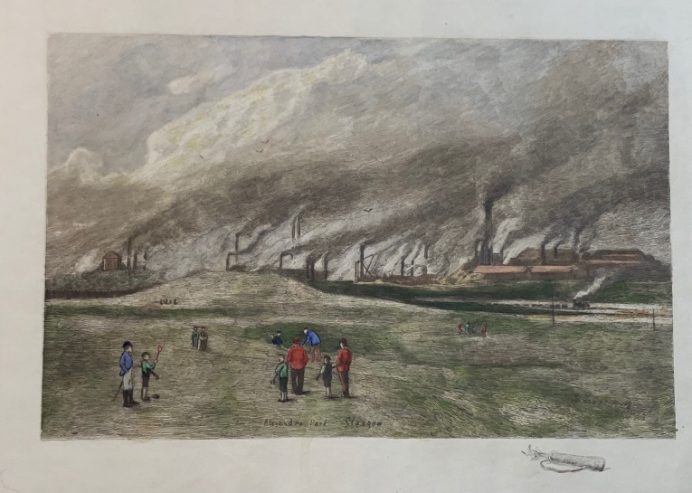
A little trivia: that is why the average score per hole is a par 4 – in honor of King James IV.
(Ok I made that last part up!)
14. True or false: If a design is poor for hickory golf, it is likely a course that will hold little overall interest.
For me, that is true. I had to abandon playing gutty golf when I moved to Florida 7 years ago. Why? The gutty game is without a doubt a game played closer to the ground and Florida (for the most part) has too many courses that overuse water as a hazard. As a developer, I understand how the state of Florida requires retention and detention ponds, but if I were to build a golf course from scratch in Florida, I would make one massive pond on the property, put the clubhouse on it and keep it off the golf course.
A bit off topic, but every golfer should play a couple of holes if not a round with hickory clubs. It will give you a new appreciation for the game.
15. What percentage of courses that you will play this year have been built after World War II?
As a historian, I try not to predict the future.
My home course is the oldest in Florida so that will certainly swing the percentage toward the pre. That being said, I try not to marry myself to one brand of golf design. Golf is at its best when we embrace diversity in every aspect including golf design. I would hope that percentage would be over 25%, but if we factor in my home course that number would be much lower. I love to see new courses so that will certainly boost my percentages and I want to explore the fascinating personality of Dick Wilson this year and I feel I can’t do that without playing some of his courses.
16. Does anything impress you about the modern game?
We are at a tipping point in the game. A good point of reference is the year of 1930. In 1930 Bobby Jones won the grand slam and in 1931 the USGA effectively rolled back the golf ball by making it larger and lighter. That experiment was nicknamed “the balloon ball” didn’t quite make it through 1931, but the end result was the ball weight and size we have today.
I am impressed that Bryson, Rory, DJ, Brooks and others can hit the ball so far – how can you not be impressed? But then you have to take a step back and ask yourself does it make the game compelling? To me, it does not. I am also impressed with this era’s golf course architects and their collective restoration efforts.
I love the minimalist movement in golf course architecture, but I want more design diversity too – we need more architects to push the boundaries of design. In my opinion, golf needs more designers like Strantz to push the boundaries of the art of design.
17. Has your deep-dive research unturned an architect whose work holds your attention? Put a slightly different way, has history been unusually cruel to any particular architect?
I wrote an article for The Golfer’s Journal which may never be published called, “The Beauty of Bad Design.” It was a look at how the Victorian age of golf design in America had beauty. Was it natural? No. Was it kind of weird to have steeple chase hazards coming out of the ground- absolutely! But our forefathers got one thing right – they made golf an adventure. They played the game with gutties and smooth face clubs seemingly unfit for the task at hand and you played over dirt and stone walls and bushes made into hazards. It would have been a glorious adventure!
If you pressed me to name an architect, I would volunteer Tom Bendelow. A lot of people have typecast his work as simplistic, and to be absolutely fair sometimes it was -but he has work with real thought and nuance. While I think it has been watered down quite a bit over the years, Tampa has a fine example of such work in Temple Terrace. I liken it to an 18-hole version of Winterpark 9 with an added bonus of width. The design is brilliant because it is built with streets lining nearly every hole (I know that sounds absurd) – this was a course built for PGA Tour players in mind and the idea was that fans could follow their favorite groups in their automobiles as they played. It was a bold and perhaps crazy idea, but it broke the mold, and it accomplished this feat without sacrificing width or the experience. There is brilliance within that course, a restoration would make it the crown jewel of Tampa golf.
18. Which are a couple of courses that you would like to see restored? I assume Temple Terrace is one?
Definitely, Temple Terrace is on a really cool piece of land with a quirkiness that makes it endearing. It has what every restoration aspires to have … width. It is built around a community but isn’t a community development. It has great lines, natural swales and its original greens are fascinating. That being said, there are also greens that may have been flattened, certainly one’s that have shrunk and others that have been slaughtered. The course also has great history as its first pro was Long Jim Barnes and Walter Hagen, Gene Sarazen, Tommy Armour and Bobby Jones were frequently guests on its fairways. It has more than bones, Temple Terrace has potential and I do not think a massive restoration would be needed to get her up on her feet again. Would it be a Top 100 course … no … but it would be a reprieve from some of the boring golf in the area. Public golf should inspire people to want to play golf and this course could do just that!
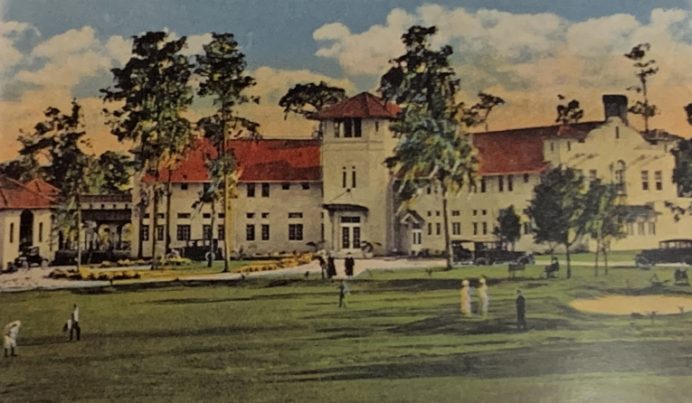
Temple Terrace, then and …

… now.
Now let me give you another public golf course that I would like to see restored but I doubt anybody would restore it the way I want it restored (and maybe that is ok)! . That is Downers Grove Golf Course, which as your readers know is the original site of CB Macdonald’s Chicago Golf Club. Some believe this site was home to the first 18 hole golf course in America (I am a bit skeptical of that claim and look forward to more research on the subject). So, I say let’s restore Downers Grove but here is the hitch: The Chicago Golf Club at Downers Grove and the Chicago Golf Club in Wheaton were in fact Victorian Golf Designs – CB Macdonald never designed his favorite template holes in Chicago, Raynor did in the 1920s. Soooooo I would argue that Downers Grove should be restored to its Victorian influences not Macdonald’s post 1900 template model. Now I know that will never happen, but I think it would be more interesting than an architect dropping templates where templates don’t belong.
19. Before we let you go, jumping across the pond, please design a one week trip to the United Kingdom for someone who appreciates history as you do.
It’s an impossible question to answer because like Ireland, I would need to know where you want to start. My favorite two courses in Scotland are the Old Course and Prestwick and you could spend a week in either area and toast Old Tom Morris and his contributions to the game. That being said no trip to Scotland is complete without a visit to Edinburgh. From Edinburgh you visit Leith Links which has more history than I can write about in one paragraph – then a hop skip and a jump you head over to Musselburgh which hosted the open championship 6 times and boasts of 5 of its own becoming Open champions (including the famous Park family). Musselburgh is also the only 9-hole course to host an Open, then to the Honourable Company of Edinburgh Golfers at Muirfield then North Berwick then Gullane to play golf and then a visit to Archie Baird’s museum. All of this would be amazing, but Scotland’s golf history is more than major championship venues, some of its best stories are from places like Shishkine & Nairn. It’s told in the villages and the stories the locals tell. You just can’t go wrong in Scotland.
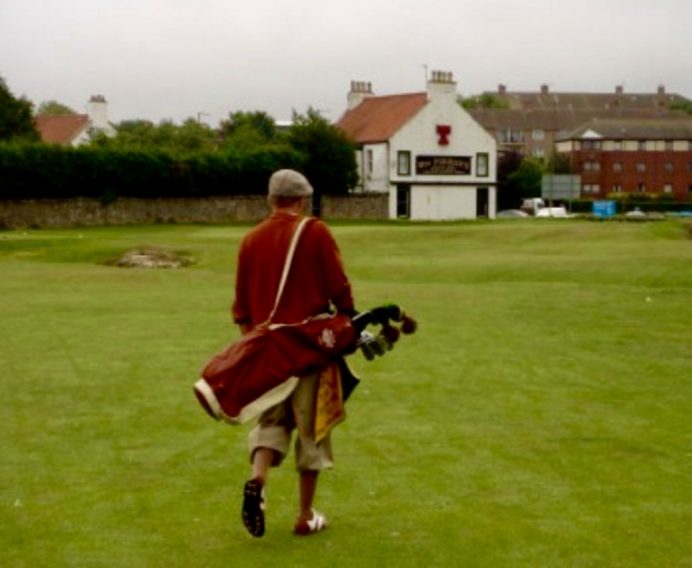
Connor Lewis, heading toward Mrs. Forman’s at Musselburgh.
20. Who do you have coming up on TalkinGolf History?
We are doing a series of histories on famous golf clubs in America: the histories of Merion, Oakmont, Newport etc…
The month leading into every major we will also tell stories of the histories of that upcoming major. An interview with Tony Jacklin for the US Open, the history of Walter Hagen for the PGA, and an interview with Mungo Park on the Park family’s legacy for the Open.
Also, though I can’t disclose much information at the moment, Vaughn Halyard and I are in the early stages of filming a documentary on the early days of golf in America and how the game evolved in North America. We have received permission to film at several historic sites/clubs and believe the film will add color to the game that we know and love today.








